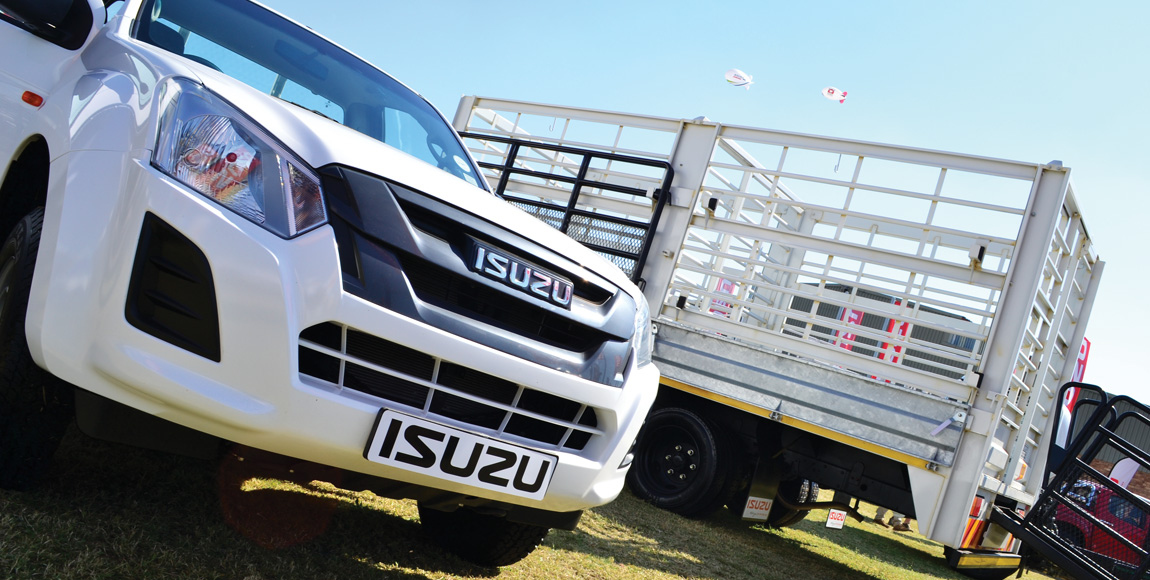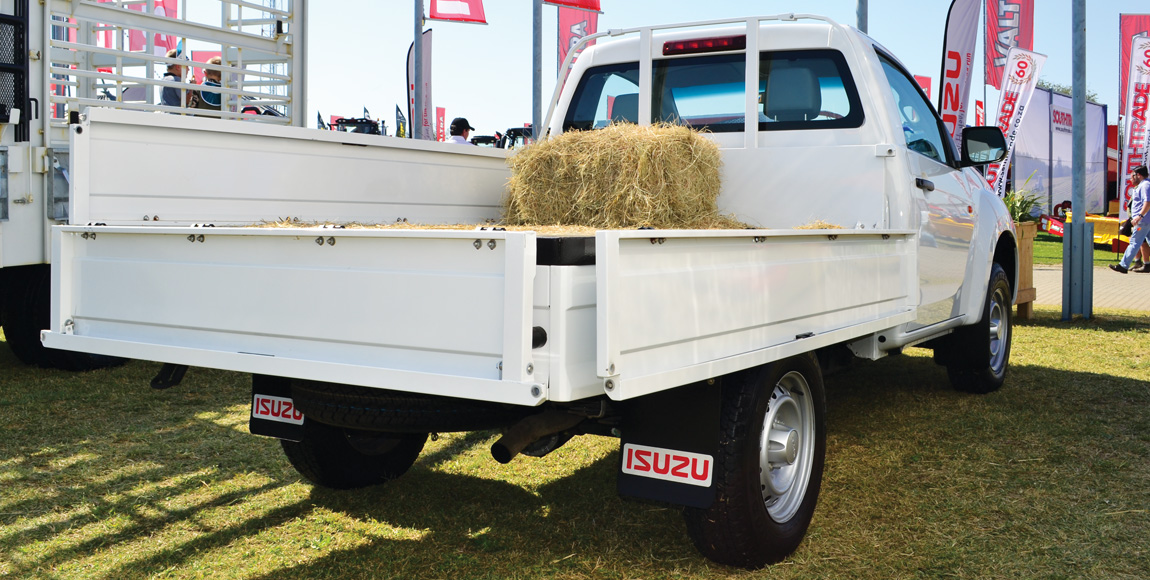SAVE-ing with Isuzu

One thing was clear from the Isuzu Motors South Africa (IMSAf) stand at the Nampo Agricultural Trade Show this year; the company has a portfolio far wider than it appears. We’re not only talking “off-the-shelf” product – but about specialised vehicles, financing and servicing solutions, driver training and parts exchange. And GAVIN MYERS finds out that it goes even deeper than that
Let’s get the most obvious part of the portfolio, the bulk of it, out the way first – the vehicles. IMSAf offers a vehicle for every need from the lightest bakkie to the heaviest trucks, and from hardy commuter buses to luxurious SUVs. The company is ever aware, though, that it is a commercial business first and foremost.
“Yes, we sell premium double cabs and the new mu-X SUV, but 80 percent of our business is with commercial customers. Isuzu has built a reputation in this space and, in particular, the brand is trusted for its reliability,” comments Tim Hendon, IMSAf marketing manager for sub-Saharan Africa.
Hendon draws a parallel in the way that IMSAf has gone about building this reputation with the traditional marketing mix of the four Ps (product, price, place and promotion) – only IMSAf follows its own version of the four Ps, using the acronym SAVE (solutions. access, value and education).
“In the commercial vehicle space a truck is an unfinished product. We need to understand our customers’ businesses and needs. Only then can we create a solution for the customer, so this is where we start; with ‘solutions’ not ‘products’,” Hendon says.
While operators of commercial vehicles are generally regarded as exceptionally hard-working, they also appreciate convenience. This is where “access” comes into the equation, replacing the “place”.
“We need to have a dealer network footprint that reaches the right areas, which is geared to serve Isuzu customers in those areas, but ‘access’ is also about being part of the community. IMSAf dealers are encouraged to get involved with their communities through various initiatives, which allows them to better understand the local culture and business infrastructure,” Hendon explains.

Indeed, many IMSAf dealers have adopted a charity or two and, through the Isuzu Child Life initiative, both dealers and IMSAf contribute to this fund for every vehicle sold.
Naturally, with the sale of a vehicle or service, inevitably customers want to know about the cost. For IMSAf, though, it’s not a question of “price”, but rather of “value”.
“The purchase price is the start of the vehicle journey, not the end,” Hendon quips. “Value is made up of what you pay to purchase the vehicle, the residual value when it’s sold on (our products tend to command better resale values than most) and what it costs to own the vehicle. In terms of cost per kilometre (CPK), we can prove that price is just the start of the conversation…”
The Isuzu ownership experience also includes aspects such as flexible financing and the warranty solution; the Isuzu Driver Academy that offers driver training from off-road 4×4, to helping truck drivers and operators get the best returns from their vehicles; and the Isuzu Drivetrain solution, that Hendon comments will have a broken-down vehicle back on the road in half the usual time.
Finally, says Hendon, Isuzu doesn’t “promote” its products in the traditional way, but rather sees this as an “educating” experience.
“Education is just as much for us as for the customer,” he adds. “Nampo, for example, is an opportunity to see what customers in the agricultural sector need. We can engage with them face to face in a non-selling way. The primary objective of ‘education’ is to better understand each other.”
So, how did all this translate on the Isuzu stand at Nampo? Naturally, the stand showed off the best of Isuzu’s products that are suited to work in the agricultural industry, beginning with the D-Max 250 Dropside. Adapted from a basic D-Max chassis cab, all four sides can drop and there is no wheel-well intrusion into the bed. The customer can also choose to fit a van body, a small cattle body, or a variety of other solutions – all while saving R10 000 over having to convert a bakkie off the showroom floor.
At the 4×4 demonstration track, Nampo visitors could experience a D-Max 250 Hi-Ride Double Cab 4×4 – carrying a fluid receptacle typical of a farming application. “It’s another solution ideal for the farming community; they need the most affordable 4×4 double cab that there is,” Hendon comments.
Moving onto the heavier models, the stand featured a NPR 400 AMT chassis cab (the truck of the bread industry, says Hendon), a NQR 500 light-duty truck fitted with a cattle body, a FTR 850 fitted with a purpose-built refrigerated meat hanger body and a FXR 17-360 cattle truck that would typically be configured to also tow a drawbar trailer.
Hendon is keen to explain that any Isuzu vehicle can be adapted to a specific customer’s needs through the IMSAf bodybuilder subsidiary Kanu. “We live our solutions,” he says. “As Kanu is 100-percent owned by IMSAf, the vehicle adaptation is considered part of the production process, so the turnaround time is very good and the customer pays only on delivery of the finished product – instead of paying for the base vehicle that cannot earn revenue while it’s being converted.”

The stand also featured a NQR 500 32-seater bus that is considered a light-duty general commuter. “This would be used for staff transportation and as a community school bus. Most farming communities are investing in their wider communities; they feel it’s the right thing to do,” Hendon elaborates.
For a bit of fun, the final attraction was a butch, bright red D-Max Arctic double cab. Built in collaboration with Arctic United Kingdom, this eye-catching, high-mobility off-road vehicle is made in the IMSAf factory, so carries the Isuzu stamp of approval.
“Nampo is always an opportunity to showcase our products, talk to our customers, show our commitment to them and learn about the agricultural industry. It’s really encouraging to hear positive noises coming from the agricultural community,” Hendon reiterates.
“In all of this, we only want to serve our customers. The Isuzu way requires our sales people to spend time with their customers, in their businesses, to consult with them and to add value.
“We’re happy being a commercial business, we’re true to that and we’re good at that. Our customers are ready for relationships – if we serve a customer it’s for the long run and we can only give effect to that by growing with them and helping them overcome their challenges with flexible solutions,” Hendon concludes.
Driving the D-Max
FOCUS was lucky enough to get behind the wheel of the top of the range D-Max 300 LX 4×4 Auto.
For four decades the most famous Isuzu on sale in South Africa has been the KB range of bakkies – that was until last year when South Africa joined the rest of the world in using the D-Max name.
Along with the new name came some updated styling touches (notice the LED rear lamp clusters, the updated grille and sharper headlamps – Bi-LED on this top-spec LX) and a couple of interior touches to pander to the ever-more leisure-orientated double-cab buyer.
Sure, this LX has keyless entry and start; comfortable leather upholstery; a power-adjusted driver’s seat and an eight-speaker, nine-inch touchscreen infotainment system with navigation and a variety of connectivity options (optional for R14 000). Do not fret, though; in the move from KB to D-Max, Isuzu has not gone soft. The D-Max feels solid; with the cabin made up from hardy, good-quality materials.
On the road, the 300 LX exhibits that same solid feel – as it should with a payload capacity of 945 kg and a towing capacity of up to 3,5 t with its standard heavy-duty tow bar.

Under the bonnet of this 300 LX is Isuzu’s famed 3,0-litre turbodiesel engine, which offers up 130 kW and 380 Nm. This engine delivers its power – through Isuzu’s electronically controlled Terrain Command 4×4 system with low range and lockable rear diff – in a smooth manner and with minimal turbo lag. The real star of the show though, is the new six-speed automatic transmission…
The addition of the extra ratio has made the KB as capable a long-distance cruiser as it is a load-lugging, rock-climbing workhorse. It shifts smoothly, holding the engine in the 1 800 to 2 800 r/min torque band for instant response to throttle inputs. It also means the 300 LX 4×4 Auto will consume a claimed 7,8 l/100 km on the combined cycle.
Ensuring ultimate stability and safety, the 300 LX has been enhanced with a traction and stability-control system that now features Trailer Sway Control. Likewise, the anti-lock braking system now features Isuzu’s Brake Override System that restricts accelerator input if the brake pedal is applied simultaneously, thereby reducing stopping distances in an emergency. Hill Start Assist and Hill Descent Control ensure roll-free pull-offs and sweat-free descents.
So, sure, it has a new name, but at R627 900, this hardy, proven double cab offers more value than ever before. Each D-Max is sold with Isuzu Complete Care that boasts a five-year/120 000 km warranty and roadside assistance and a five-year/unlimited distance anti-corrosion warranty, while each 15 000 km service will be covered for five years/90 000 km.
Published by
Focus on Transport
focusmagsa



